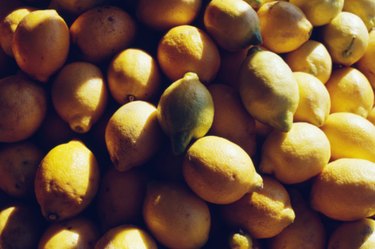
Vitamin C, also known as ascorbic acid, is an essential compound in the human diet that is required for the synthesis of collagen, a structural component in the assembly of blood vessels as well as tendons, ligaments and bone. It's found almost exclusively in plant-related food such as vegetables and fruits. Citrus fruits are the most well-known vitamin C source, but not necessarily the best because of their high acidity.
Citric Acid
Video of the Day
Citric acid is an organic acid found within certain citrus fruits. Pure lemon juice and lime juice, and the fruits from which they derive, are the richest sources of citric acid, containing 1.44 and 1.38 g/oz. respectively. On the pH scale, with one being highly acidic and 14 being alkaline, lemon juice scores 2.4. Oranges and grapefruits are also common citrus fruits that contain citric acid.
Video of the Day
Confusion
People tend to confuse ascorbic acid and citric acid, but chemically the difference is one of degrees. That is why they are often, but not always, associated. Vitamin C is generally more widespread, at least in plants, where it plays a role in reducing the stress of photosynthesis. However, it's an essential vitamin for all living things.
Sources
All fruits and vegetables contain some amount of vitamin C. However, the best non-citrus sources include strawberries and other types of berries, tomatoes, red and green peppers, cantaloupes, mangoes, potatoes, kiwis and leafy greens.
The amount of citric acid and ascorbic acid is not always proportionate. For example, both red peppers and strawberries, lacking citric acid, contain 95 and 85 mg of vitamin C, respectively, which is more than the amount found in an orange. Vitamin C can also be taken as a supplement or additive without any of the accompanying citric acid.
Considerations
Citric acid is critical to the metabolism of living organisms — in fact, one step of the metabolic process is known as the citric acid cycle — but organisms also manufacture their own citric acid independent of whether or not it is consumed. The same is also true of vitamin C in most organisms except humans. Humans do not have the ability to manufacture vitamin C and must therefore obtain it through their diet. This means that humans can eat vitamin C from sources such as strawberries and tomatoes without the need to eat citrus fruits too.
- Oregon State University Linus Pauling Institute; Vitamin C; Jane Higdon; January 2006
- "Journal of Endourology"; Quantitative Assessment of Citric Acid in Lemon Juice, Lime Juice, and Commercially-Available Fruit Juice Products; Kristina L. Penniston, et al.; March 2008
- University of Maryland Medical Center; Vitamin C (Ascorbic Acid); Steven D. Ehrlich; June 2009